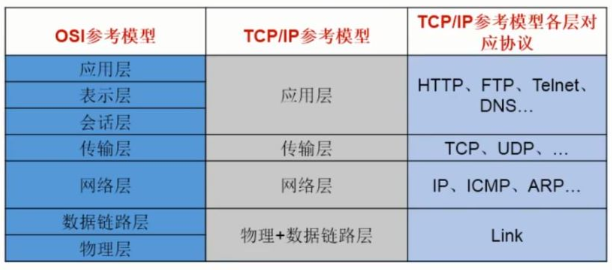Java 基础 (网络编程)
Java 是 Internet上的语言,它从语言级上提供了对网络应用程序的支持,程序员能够很容易开发常见的网络应用程序。
Java 提供的网络类库,可以实现无痛的网络连接,联网的底层细节被隐藏在 Java 的本机安装系统里,由 JVM 进行控制。并且 Java 实现了一个跨平台的网络库,程序员面对的是一个统一的网络编程环境。
实现网络中的主机互相通信
1.通信双方地址
IP
端口号
2.一定的规则 (即:网络通信协议。有两套参考模型)
OSI 参考模型: 模型过于理想化,未能在因特网上进行广泛推广
TCP/IP 参考模型(或TCP/IP协议): 事实上的国际标准。
网络通信协议

端口分类
公认端口: 0~1023。被预先定义的服务通信占用(如:HTTP占用端口80,FTP占用端口21,Telnet占用端口23)
注册端口: 1024~49151。分配给用户进程或应用程序。(如:Tomcat占用端口8080,MySQL占用端口3306,Oracle占用端口1521等)。
动态/私有端口:49152~65535。
端口号与IP地址的组合得出一个网络套接字:Socket。
TCP 和 UDP
TCP协议 > 使用TCP协议前,须先建立TCP连接,形成传输数据通道 > 传输前,采用“三次握手”方式,点对点通信,是可靠的 > TCP协议进行通信的两个应用进程:客户端、服务端。 > 在连接中可进行大数据量的传输 > 传输完毕,需释放已建立的连接,效率低 UDP协议 > 将数据、源、目的封装成数据包,不需要建立连接 > 每个数据报的大小限制在64K内 > 发送不管对方是否准备好,接收方收到也不确认,故是不可靠的 > 可以广播发送 > 发送数据结束时无需释放资源,开销小,速度快
TCP
TCPTest1.java
package com.klvchen.java1; import org.junit.Test; import java.io.ByteArrayOutputStream; import java.io.IOException; import java.io.InputStream; import java.io.OutputStream; import java.net.InetAddress; import java.net.ServerSocket; import java.net.Socket; public class TCPTest1 { //客户端 @Test public void client(){ Socket socket = null; OutputStream os = null; try { //1.创建Socket对象,指明服务器端的ip和端口号 InetAddress inet = InetAddress.getByName("127.0.0.1"); socket = new Socket(inet, 8899); //2.获取一个输出流,用于输出数据 os = socket.getOutputStream(); //3. 写出数据的操作 os.write("你好,我是客户端mm".getBytes()); } catch (IOException e) { e.printStackTrace(); } finally { //4.资源的关闭 if (os != null) { try { os.close(); } catch (IOException e) { e.printStackTrace(); } } if (socket != null) { try { socket.close(); } catch (IOException e) { e.printStackTrace(); } } } } //服务器 @Test public void server(){ ServerSocket ss = null; Socket socket = null; InputStream is = null; ByteArrayOutputStream baos = null; try { //1.创建服务器端的ServerSocket,指明自己的端口号 ss = new ServerSocket(8899); //2.调用accept()表示接收来自于客户端的socket socket = ss.accept(); //3.获取输入流 is = socket.getInputStream(); // 不建议这样写,可能会有乱码 //byte[] buffer = new byte[20]; //int len; //while ((len = is.read(buffer)) != -1) { // String str = new String(buffer, 0, len); // System.out.println(str); //} //4.读取输入流中的数据 baos = new ByteArrayOutputStream(); byte[] buffer = new byte[5]; int len; while ((len = is.read(buffer)) != -1) { baos.write(buffer, 0 , len); } System.out.println(baos.toString()); System.out.println("收到来自于:" + socket.getInetAddress().getHostAddress() + "的数据"); } catch (IOException e) { e.printStackTrace(); } finally { //5.关闭资源 if (baos != null) { try { baos.close(); } catch (IOException e) { e.printStackTrace(); } } if (is != null) { try { is.close(); } catch (IOException e) { e.printStackTrace(); } } if (socket != null) { try { socket.close(); } catch (IOException e) { e.printStackTrace(); } } if (ss != null) { try { ss.close(); } catch (IOException e) { e.printStackTrace(); } } } } }
TCPTest2.java
package com.klvchen.java1; import org.junit.Test; import java.io.*; import java.net.InetAddress; import java.net.ServerSocket; import java.net.Socket; /* 客户端发送文件给服务端,服务端将文件保存在本地 */ public class TCPTest2 { @Test public void client() throws IOException { Socket socket = new Socket(InetAddress.getByName("127.0.0.1"), 9090); OutputStream os = socket.getOutputStream(); FileInputStream fis = new FileInputStream(new File("1.png")); byte[] buffer = new byte[1024]; int len; while ((len = fis.read(buffer)) != -1) { os.write(buffer, 0, len); } fis.close(); os.close(); socket.close(); } @Test public void server() throws IOException{ ServerSocket ss = new ServerSocket(9090); Socket socket = ss.accept(); InputStream is = socket.getInputStream(); FileOutputStream fos = new FileOutputStream(new File("4.png")); byte[] buffer = new byte[1024]; int len; while ((len = is.read(buffer)) != -1) { fos.write(buffer, 0, len); } fos.close(); is.close(); socket.close(); ss.close(); } }
TCPTest3.java
package com.klvchen.java1; import org.junit.Test; import java.io.*; import java.net.InetAddress; import java.net.ServerSocket; import java.net.Socket; /* 从客户端发送文件给服务端,服务端保存到本地。并返回“发送成功”给客户端。 */ public class TCPTest3 { @Test public void client() throws IOException { Socket socket = new Socket(InetAddress.getByName("127.0.0.1"), 9090); OutputStream os = socket.getOutputStream(); FileInputStream fis = new FileInputStream(new File("1.png")); byte[] buffer = new byte[1024]; int len; while ((len = fis.read(buffer)) != -1) { os.write(buffer, 0, len); } socket.shutdownOutput(); //接收来自于服务器端的数据,并显示到控制台上 InputStream is = socket.getInputStream(); ByteArrayOutputStream baos = new ByteArrayOutputStream(); byte[] bufferr = new byte[1024]; int len1; while ((len1 = is.read(bufferr)) != -1) { baos.write(bufferr,0,len1); } System.out.println(baos.toString()); fis.close(); os.close(); socket.close(); baos.close(); is.close(); } @Test public void server() throws IOException{ ServerSocket ss = new ServerSocket(9090); Socket socket = ss.accept(); InputStream is = socket.getInputStream(); FileOutputStream fos = new FileOutputStream(new File("4.png")); byte[] buffer = new byte[1024]; int len; while ((len = is.read(buffer)) != -1) { fos.write(buffer, 0, len); } OutputStream os = socket.getOutputStream(); os.write("你好,美女,照片我已收到,非常漂亮!".getBytes()); fos.close(); is.close(); socket.close(); ss.close(); os.close(); } }
UDP
UDPTest.java
package com.klvchen.java1; import org.junit.Test; import java.io.IOException; import java.net.*; public class UDPTest { @Test public void sender() throws IOException { DatagramSocket socket = new DatagramSocket(); String str = "我是UDP方式发送的导弹"; byte[] data = str.getBytes(); InetAddress inet = InetAddress.getLocalHost(); DatagramPacket packet = new DatagramPacket(data, 0, data.length,inet,9090); socket.send(packet); socket.close(); } @Test public void receiver() throws IOException{ DatagramSocket socket = new DatagramSocket(9090); byte[] buffer = new byte[100]; DatagramPacket packet = new DatagramPacket(buffer,0,buffer.length); socket.receive(packet); System.out.println(new String(packet.getData(), 0, packet.getLength())); socket.close(); } }
URL
* URL(Uniform Resource Locator): 统一资源定位符,它表示 Internet 上某一资源的地址。 * 它是一种具体的URI,即URL可以用来标识一个资源,而且还指明了如何locate这个资源。 * 通过URL我们可以访问 Internet上的各种网络资源,比如最常见的 www,ftp站点。浏览器通过解析给定的URL可以在网络上查找相应的文件或其他资源。 * URL的基本结构由5部分组成: <传输协议>://<主机名>:<端口号>/<文件名>#片段名?参数列表 例如: http://192.168.1.100:8080/helloworld/index.jsp#a?username=shkstart&password=123
URLTest.java
package com.klvchen.java1; import java.net.MalformedURLException; import java.net.URL; public class URLTest { public static void main(String[] args){ URL url = null; try { url = new URL("https://gimg2.baidu.com/image_search/src=http%3A%2F%2Fb-ssl.duitang.com%2Fuploads%2Fitem%2F201810%2F05%2F20181005142528_yinka.jpg&refer=http%3A%2F%2Fb-ssl.duitang.com&app=2002&size=f9999,10000&q=a80&n=0&g=0n&fmt=jpeg?sec=1638864631&t=26377d1d4652702f21909f93fee1af0e"); // 获取URL的协议名称 System.out.println(url.getProtocol()); // 获取该URL的主机名 System.out.println(url.getHost()); // 获取该URL的端口号 System.out.println(url.getPort()); //获取该URL的文件路径 System.out.println(url.getPath()); //获取该URL的文件名 System.out.println(url.getFile()); // 获取该URL的查询名 System.out.println(url.getQuery()); } catch (MalformedURLException e) { e.printStackTrace(); } } }
URLTest1.java
package com.klvchen.java1; import java.io.FileOutputStream; import java.io.IOException; import java.io.InputStream; import java.net.HttpURLConnection; import java.net.URL; public class URLTest1 { public static void main(String[] args){ HttpURLConnection urlConnection = null; InputStream is = null; FileOutputStream fos = null; try { URL url = new URL("https://gimg2.baidu.com/image_search/src=http%3A%2F%2Fb-ssl.duitang.com%2Fuploads%2Fitem%2F201810%2F05%2F20181005142528_yinka.jpg&refer=http%3A%2F%2Fb-ssl.duitang.com&app=2002&size=f9999,10000&q=a80&n=0&g=0n&fmt=jpeg?sec=1638864631&t=26377d1d4652702f21909f93fee1af0e"); urlConnection = (HttpURLConnection) url.openConnection(); urlConnection.connect(); is = urlConnection.getInputStream(); fos = new FileOutputStream("day10\\5.jpeg"); byte[] buffer = new byte[1024]; int len; while ((len = is.read(buffer)) != -1) { fos.write(buffer, 0, len); } System.out.println("下载完成"); } catch (IOException e) { e.printStackTrace(); } finally { if (is != null) { try { is.close(); } catch (IOException e) { e.printStackTrace(); } } if (fos != null) { try { fos.close(); } catch (IOException e) { e.printStackTrace(); } } if (urlConnection != null) { urlConnection.disconnect(); } } } }




【推荐】国内首个AI IDE,深度理解中文开发场景,立即下载体验Trae
【推荐】编程新体验,更懂你的AI,立即体验豆包MarsCode编程助手
【推荐】抖音旗下AI助手豆包,你的智能百科全书,全免费不限次数
【推荐】轻量又高性能的 SSH 工具 IShell:AI 加持,快人一步
· 开发者必知的日志记录最佳实践
· SQL Server 2025 AI相关能力初探
· Linux系列:如何用 C#调用 C方法造成内存泄露
· AI与.NET技术实操系列(二):开始使用ML.NET
· 记一次.NET内存居高不下排查解决与启示
· 开源Multi-agent AI智能体框架aevatar.ai,欢迎大家贡献代码
· Manus重磅发布:全球首款通用AI代理技术深度解析与实战指南
· 被坑几百块钱后,我竟然真的恢复了删除的微信聊天记录!
· 没有Manus邀请码?试试免邀请码的MGX或者开源的OpenManus吧
· 园子的第一款AI主题卫衣上架——"HELLO! HOW CAN I ASSIST YOU TODAY